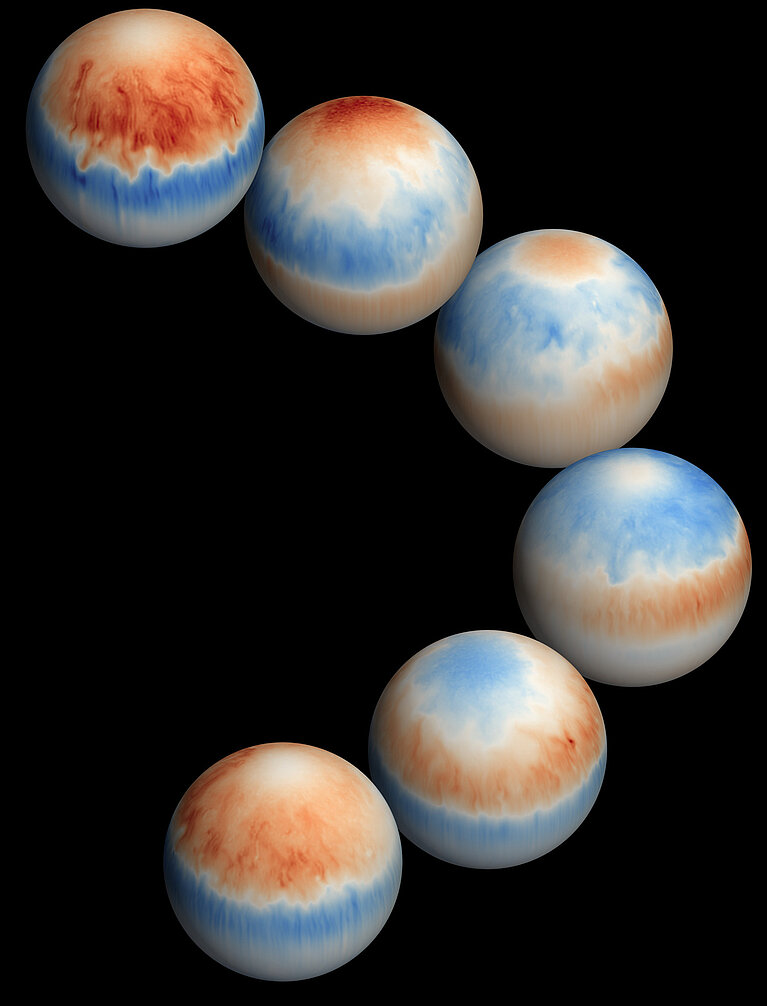November 07, 2016 - by Simone Ulmer
In November 2013 the European Space Agency (ESA) sent three satellites into space (see ETH News from 22.11.2013), which have since been making precise measurements of Earth's magnetic field. For this continues to hold scientific mysteries: as an example, the causal mechanism for the magnetic field reversals remains unclear to this day. One possible mechanism has now been identified by ETH scientists Andrew Jackson and Andrey Sheyko together with Chris Finlay of the Technical University of Denmark, based on simulations performed on the "Piz Daint" supercomputer. Their results were published today in the scientific journal "Nature"1.
Earth’s molten core in motion as a magnetic field generator
Simulations, seismic measurements and the physical properties of minerals – from those we know the composition of Earth’s deep interior – have so far been the only avenues for researching the emergence of our planet’s magnetic field. Because the magnetism acts as a shield against cosmic radiation as well as a navigation system for birds and other animal species, this makes a particularly interesting research topic.
According to present-day knowledge, the so-called ‘geodynamo’ is very likely run by processes taking place in Earth’s inner and outer core. Whereas the inner core is solid and composed mostly of iron and nickel, the outer core is liquid and contains lighter elements as well. The liquid is so hot that the metals in it are no longer magnetic, although they are still able to conduct electricity and heat. Because heavier elements in the outer core tend to sink inward and solidify there, the lighter elements are forced upward.
This process, together with temperature differentials at the boundaries between the inner and outer core and the core and the Earth’s mantle, is thought to cause circulating convection currents in the molten core. These are simultaneously affected by a Coriolis force resulting from the Earth’s rotation. The Coriolis force produces eddies in the molten metal that run perpendicular to the convection currents, which themselves move parallel to Earth’s rotational axis. This induces an electrical current that ultimately gives rise to a dipole magnetic field (north and south poles) as well as weaker, multipolar components.
Two material properties are key to the magnetic field and its reversal: One of these is the viscosity of Earth’s core, which determines how rapidly the core convection currents come to rest. The other is electrical conductivity, which determines the magnetic field’s rate of decay. In previous simulations, both these factors took place at the same tempo. “In our simulation, we let the magnetic field decay twenty times faster than the convection currents in the molten core”, says ETH professor Andrew Jackson, a co-author of the study. In this way the scientists reduced the value of the coefficient setting the ratio between the two material properties, and approached Earth-like conditions more closely than in earlier simulations.
The actual simulation goal was to investigate the stability of the magnetic field. A field reversal occurred after a certain time, followed by others at periodic intervals, reports Jackson. The only explanation for the observed field reversal was the influence of so-called dynamo waves. “This is the first simulation under non slip boundary conditions to produce a field reversal where dynamo waves would appear to be the cause”, says Sheyko. ‘Non slip’ refers to realistic conditions that a liquid experiences when friction acts at its boundary, in this case the shell of the outer core.
Dynamo waves are powerful global disturbances of the magnetic field emanating from the core. Their existence was postulated in 1955 as an explanation for periodic field reversals in the sun that take place every eleven years. Although there exist significant differences between Earth’s magnetic field and that of the sun, the latest research results indicate dynamo waves playing a role in magnetic field reversals within our planet as well.
Idealised conditions
Simulation of highly complex processes in three dimensions requires extremely powerful supercomputers, and even these can only perform approximate calculations of Earth-like conditions. The research team took as the basis of their simulation a model developed in 2009: it assumed low viscosity while adding in a new factor, namely constant heat flux at the surface of Earth’s core2.
This was the first time that a sufficiently strong and stable magnetic field under Earth-like conditions could be simulated. The researchers now supplemented this model with idealised conditions, assuming for simulation purposes the Earth-like planet was spherical, for example. At the same time they came closer to Earth-like conditions by letting the magnetic field and the current in the molten core decay at different rates. Using four million CPU hours on "Piz Daint", the researchers were able to simulate magnetic field dispersion and the time taken to reverse polarity for a planetary dynamo with lower viscosity and higher rotational speed than had ever been accomplished before.
In the simulation, a strong dipole magnetic field developed and periodically reversed itself every few thousand years. But in reality, Earth’s magnetic field has reversed several hundred times at more or less irregular intervals – every 500,000 years or so in recent epochs. There is a marked difference from the simulated dipole field inasmuch as the Earth’s field neither reverses with such consistent periodicity, nor exhibits the same combination of symmetries. “The physics underlying the simulation do in fact correspond to those of the Earth”, says Andrew Jackson. But since the simulation still differs by orders of magnitude from real conditions on and inside the planet, for now the model provides only an indication that dynamo waves might play a role in magnetic field reversals.
References
1 Sheyko A, Finlay CC & Jackson, A: Magnetic reversals from planetary dynamo waves. Nature advanced online publication (2016), DOI: dx.doi.org/10.1038/nature19842.
2 Sakuraba A & Roberts PH: Generation of a strong magnetic field using uniform heat flux at the surface of the core. Nature Geoscience 2 (11), 802-805 (2009).

